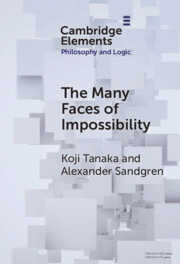Element contents
The Many Faces of Impossibility
Published online by Cambridge University Press: 28 February 2024
Summary
Keywords
- Type
- Element
- Information
- Series: Elements in Philosophy and LogicOnline ISBN: 9781009180573Publisher: Cambridge University PressPrint publication: 28 March 2024
References
- 8
- Cited by

